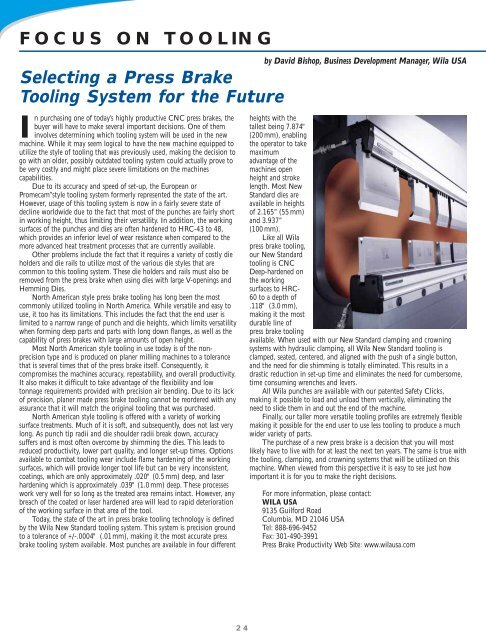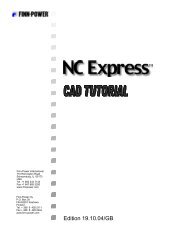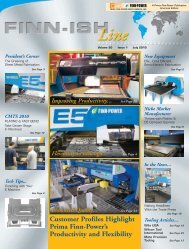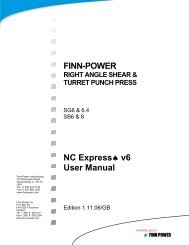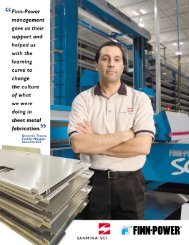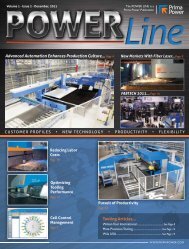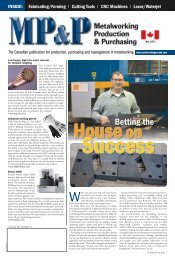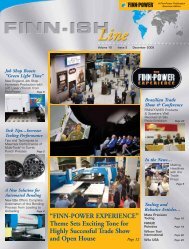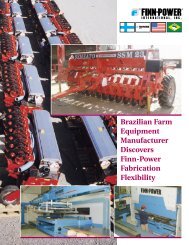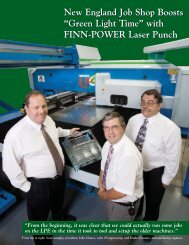“Finn-Power is the only machine builder that took a position on the ...
“Finn-Power is the only machine builder that took a position on the ...
“Finn-Power is the only machine builder that took a position on the ...
Create successful ePaper yourself
Turn your PDF publications into a flip-book with our unique Google optimized e-Paper software.
FOCUS ON TOOLING<br />
Selecting a Press Brake<br />
Tooling System for <str<strong>on</strong>g>the</str<strong>on</strong>g> Future<br />
In purchasing <strong>on</strong>e of today’s highly productive CNC press brakes, <str<strong>on</strong>g>the</str<strong>on</strong>g><br />
buyer will have to make several important dec<str<strong>on</strong>g>is</str<strong>on</strong>g>i<strong>on</strong>s. One of <str<strong>on</strong>g>the</str<strong>on</strong>g>m<br />
involves determining which tooling system will be used in <str<strong>on</strong>g>the</str<strong>on</strong>g> new<br />
<str<strong>on</strong>g>machine</str<strong>on</strong>g>. While it may seem logical to have <str<strong>on</strong>g>the</str<strong>on</strong>g> new <str<strong>on</strong>g>machine</str<strong>on</strong>g> equipped to<br />
utilize <str<strong>on</strong>g>the</str<strong>on</strong>g> style of tooling <str<strong>on</strong>g>that</str<strong>on</strong>g> was previously used, making <str<strong>on</strong>g>the</str<strong>on</strong>g> dec<str<strong>on</strong>g>is</str<strong>on</strong>g>i<strong>on</strong> to<br />
go with an older, possibly outdated tooling system could actually prove to<br />
be very costly and might place severe limitati<strong>on</strong>s <strong>on</strong> <str<strong>on</strong>g>the</str<strong>on</strong>g> <str<strong>on</strong>g>machine</str<strong>on</strong>g>s<br />
capabilities.<br />
Due to its accuracy and speed of set-up, <str<strong>on</strong>g>the</str<strong>on</strong>g> European or<br />
Promecam”style tooling system formerly represented <str<strong>on</strong>g>the</str<strong>on</strong>g> state of <str<strong>on</strong>g>the</str<strong>on</strong>g> art.<br />
However, usage of th<str<strong>on</strong>g>is</str<strong>on</strong>g> tooling system <str<strong>on</strong>g>is</str<strong>on</strong>g> now in a fairly severe state of<br />
decline worldwide due to <str<strong>on</strong>g>the</str<strong>on</strong>g> fact <str<strong>on</strong>g>that</str<strong>on</strong>g> most of <str<strong>on</strong>g>the</str<strong>on</strong>g> punches are fairly short<br />
in working height, thus limiting <str<strong>on</strong>g>the</str<strong>on</strong>g>ir versatility. In additi<strong>on</strong>, <str<strong>on</strong>g>the</str<strong>on</strong>g> working<br />
surfaces of <str<strong>on</strong>g>the</str<strong>on</strong>g> punches and dies are often hardened to HRC-43 to 48,<br />
which provides an inferior level of wear res<str<strong>on</strong>g>is</str<strong>on</strong>g>tance when compared to <str<strong>on</strong>g>the</str<strong>on</strong>g><br />
more advanced heat treatment processes <str<strong>on</strong>g>that</str<strong>on</strong>g> are currently available.<br />
O<str<strong>on</strong>g>the</str<strong>on</strong>g>r problems include <str<strong>on</strong>g>the</str<strong>on</strong>g> fact <str<strong>on</strong>g>that</str<strong>on</strong>g> it requires a variety of costly die<br />
holders and die rails to utilize most of <str<strong>on</strong>g>the</str<strong>on</strong>g> various die styles <str<strong>on</strong>g>that</str<strong>on</strong>g> are<br />
comm<strong>on</strong> to th<str<strong>on</strong>g>is</str<strong>on</strong>g> tooling system. These die holders and rails must also be<br />
removed from <str<strong>on</strong>g>the</str<strong>on</strong>g> press brake when using dies with large V-openings and<br />
Hemming Dies.<br />
North American style press brake tooling has l<strong>on</strong>g been <str<strong>on</strong>g>the</str<strong>on</strong>g> most<br />
comm<str<strong>on</strong>g><strong>on</strong>ly</str<strong>on</strong>g> utilized tooling in North America. While versatile and easy to<br />
use, it too has its limitati<strong>on</strong>s. Th<str<strong>on</strong>g>is</str<strong>on</strong>g> includes <str<strong>on</strong>g>the</str<strong>on</strong>g> fact <str<strong>on</strong>g>that</str<strong>on</strong>g> <str<strong>on</strong>g>the</str<strong>on</strong>g> end user <str<strong>on</strong>g>is</str<strong>on</strong>g><br />
limited to a narrow range of punch and die heights, which limits versatility<br />
when forming deep parts and parts with l<strong>on</strong>g down flanges, as well as <str<strong>on</strong>g>the</str<strong>on</strong>g><br />
capability of press brakes with large amounts of open height.<br />
Most North American style tooling in use today <str<strong>on</strong>g>is</str<strong>on</strong>g> of <str<strong>on</strong>g>the</str<strong>on</strong>g> n<strong>on</strong>prec<str<strong>on</strong>g>is</str<strong>on</strong>g>i<strong>on</strong><br />
type and <str<strong>on</strong>g>is</str<strong>on</strong>g> produced <strong>on</strong> planer milling <str<strong>on</strong>g>machine</str<strong>on</strong>g>s to a tolerance<br />
<str<strong>on</strong>g>that</str<strong>on</strong>g> <str<strong>on</strong>g>is</str<strong>on</strong>g> several times <str<strong>on</strong>g>that</str<strong>on</strong>g> of <str<strong>on</strong>g>the</str<strong>on</strong>g> press brake itself. C<strong>on</strong>sequently, it<br />
comprom<str<strong>on</strong>g>is</str<strong>on</strong>g>es <str<strong>on</strong>g>the</str<strong>on</strong>g> <str<strong>on</strong>g>machine</str<strong>on</strong>g>s accuracy, repeatability, and overall productivity.<br />
It also makes it difficult to take advantage of <str<strong>on</strong>g>the</str<strong>on</strong>g> flexibility and low<br />
t<strong>on</strong>nage requirements provided with prec<str<strong>on</strong>g>is</str<strong>on</strong>g>i<strong>on</strong> air bending. Due to its lack<br />
of prec<str<strong>on</strong>g>is</str<strong>on</strong>g>i<strong>on</strong>, planer made press brake tooling cannot be reordered with any<br />
assurance <str<strong>on</strong>g>that</str<strong>on</strong>g> it will match <str<strong>on</strong>g>the</str<strong>on</strong>g> original tooling <str<strong>on</strong>g>that</str<strong>on</strong>g> was purchased.<br />
North American style tooling <str<strong>on</strong>g>is</str<strong>on</strong>g> offered with a variety of working<br />
surface treatments. Much of it <str<strong>on</strong>g>is</str<strong>on</strong>g> soft, and subsequently, does not last very<br />
l<strong>on</strong>g. As punch tip radii and die shoulder radii break down, accuracy<br />
suffers and <str<strong>on</strong>g>is</str<strong>on</strong>g> most often overcome by shimming <str<strong>on</strong>g>the</str<strong>on</strong>g> dies. Th<str<strong>on</strong>g>is</str<strong>on</strong>g> leads to<br />
reduced productivity, lower part quality, and l<strong>on</strong>ger set-up times. Opti<strong>on</strong>s<br />
available to combat tooling wear include flame hardening of <str<strong>on</strong>g>the</str<strong>on</strong>g> working<br />
surfaces, which will provide l<strong>on</strong>ger tool life but can be very inc<strong>on</strong>s<str<strong>on</strong>g>is</str<strong>on</strong>g>tent,<br />
coatings, which are <str<strong>on</strong>g><strong>on</strong>ly</str<strong>on</strong>g> approximately .020" (0.5 mm) deep, and laser<br />
hardening which <str<strong>on</strong>g>is</str<strong>on</strong>g> approximately .039" (1.0 mm) deep. These processes<br />
work very well for so l<strong>on</strong>g as <str<strong>on</strong>g>the</str<strong>on</strong>g> treated area remains intact. However, any<br />
breach of <str<strong>on</strong>g>the</str<strong>on</strong>g> coated or laser hardened area will lead to rapid deteriorati<strong>on</strong><br />
of <str<strong>on</strong>g>the</str<strong>on</strong>g> working surface in <str<strong>on</strong>g>that</str<strong>on</strong>g> area of <str<strong>on</strong>g>the</str<strong>on</strong>g> tool.<br />
Today, <str<strong>on</strong>g>the</str<strong>on</strong>g> state of <str<strong>on</strong>g>the</str<strong>on</strong>g> art in press brake tooling technology <str<strong>on</strong>g>is</str<strong>on</strong>g> defined<br />
by <str<strong>on</strong>g>the</str<strong>on</strong>g> Wila New Standard tooling system. Th<str<strong>on</strong>g>is</str<strong>on</strong>g> system <str<strong>on</strong>g>is</str<strong>on</strong>g> prec<str<strong>on</strong>g>is</str<strong>on</strong>g>i<strong>on</strong> ground<br />
to a tolerance of +/-.0004" (.01mm), making it <str<strong>on</strong>g>the</str<strong>on</strong>g> most accurate press<br />
brake tooling system available. Most punches are available in four different<br />
24<br />
by David B<str<strong>on</strong>g>is</str<strong>on</strong>g>hop, Business Development Manager, Wila USA<br />
heights with <str<strong>on</strong>g>the</str<strong>on</strong>g><br />
tallest being 7.874"<br />
(200 mm), enabling<br />
<str<strong>on</strong>g>the</str<strong>on</strong>g> operator to take<br />
maximum<br />
advantage of <str<strong>on</strong>g>the</str<strong>on</strong>g><br />
<str<strong>on</strong>g>machine</str<strong>on</strong>g>s open<br />
height and stroke<br />
length. Most New<br />
Standard dies are<br />
available in heights<br />
of 2.165” (55 mm)<br />
and 3.937”<br />
(100 mm).<br />
Like all Wila<br />
press brake tooling,<br />
our New Standard<br />
tooling <str<strong>on</strong>g>is</str<strong>on</strong>g> CNC<br />
Deep-hardened <strong>on</strong><br />
<str<strong>on</strong>g>the</str<strong>on</strong>g> working<br />
surfaces to HRC-<br />
60 to a depth of<br />
.118" (3.0 mm),<br />
making it <str<strong>on</strong>g>the</str<strong>on</strong>g> most<br />
durable line of<br />
press brake tooling<br />
available. When used with our New Standard clamping and crowning<br />
systems with hydraulic clamping, all Wila New Standard tooling <str<strong>on</strong>g>is</str<strong>on</strong>g><br />
clamped, seated, centered, and aligned with <str<strong>on</strong>g>the</str<strong>on</strong>g> push of a single butt<strong>on</strong>,<br />
and <str<strong>on</strong>g>the</str<strong>on</strong>g> need for die shimming <str<strong>on</strong>g>is</str<strong>on</strong>g> totally eliminated. Th<str<strong>on</strong>g>is</str<strong>on</strong>g> results in a<br />
drastic reducti<strong>on</strong> in set-up time and eliminates <str<strong>on</strong>g>the</str<strong>on</strong>g> need for cumbersome,<br />
time c<strong>on</strong>suming wrenches and levers.<br />
All Wila punches are available with our patented Safety Clicks,<br />
making it possible to load and unload <str<strong>on</strong>g>the</str<strong>on</strong>g>m vertically, eliminating <str<strong>on</strong>g>the</str<strong>on</strong>g><br />
need to slide <str<strong>on</strong>g>the</str<strong>on</strong>g>m in and out <str<strong>on</strong>g>the</str<strong>on</strong>g> end of <str<strong>on</strong>g>the</str<strong>on</strong>g> <str<strong>on</strong>g>machine</str<strong>on</strong>g>.<br />
Finally, our taller more versatile tooling profiles are extremely flexible<br />
making it possible for <str<strong>on</strong>g>the</str<strong>on</strong>g> end user to use less tooling to produce a much<br />
wider variety of parts.<br />
The purchase of a new press brake <str<strong>on</strong>g>is</str<strong>on</strong>g> a dec<str<strong>on</strong>g>is</str<strong>on</strong>g>i<strong>on</strong> <str<strong>on</strong>g>that</str<strong>on</strong>g> you will most<br />
likely have to live with for at least <str<strong>on</strong>g>the</str<strong>on</strong>g> next ten years. The same <str<strong>on</strong>g>is</str<strong>on</strong>g> true with<br />
<str<strong>on</strong>g>the</str<strong>on</strong>g> tooling, clamping, and crowning systems <str<strong>on</strong>g>that</str<strong>on</strong>g> will be utilized <strong>on</strong> th<str<strong>on</strong>g>is</str<strong>on</strong>g><br />
<str<strong>on</strong>g>machine</str<strong>on</strong>g>. When viewed from th<str<strong>on</strong>g>is</str<strong>on</strong>g> perspective it <str<strong>on</strong>g>is</str<strong>on</strong>g> easy to see just how<br />
important it <str<strong>on</strong>g>is</str<strong>on</strong>g> for you to make <str<strong>on</strong>g>the</str<strong>on</strong>g> right dec<str<strong>on</strong>g>is</str<strong>on</strong>g>i<strong>on</strong>s.<br />
For more informati<strong>on</strong>, please c<strong>on</strong>tact:<br />
WILA USA<br />
9135 Guilford Road<br />
Columbia, MD 21046 USA<br />
Tel: 888-696-9452<br />
Fax: 301-490-3991<br />
Press Brake Productivity Web Site: www.wilausa.com


